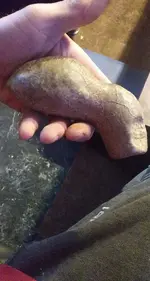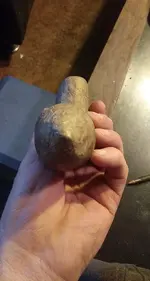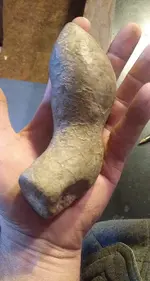Nice curiosity. You can see from the web-like relief patterning (particularly in pictures 1 and 3) that this is a concretionary form. That kind of patterning is akin to what we call ‘septarian’ and although we aren’t sure how it happens, it’s generally held to be the result of compression or dehydration of sediments while the concretion is forming.
These curious shapes ae not uncommon in sedimentary rocks (all of Ohio's surface geology is sedimentary) and usually they have formed by mineral precipitation around mudstone or siltstone infilling cavities in the surrounding rock matrix. The cavities are usually marine in nature and arise from clumps of decayed organic matter (notably things like algae and sponges) or from burrowing activity by mud-dwelling animals.
So, the overall shape is natural in areas where you can see that web-like pattern standing proud of the surface, which seems to be pretty much all of it. If you examine more closely, it may just be possible that it has been modified in places to refine its shape… the pointed end for example. in which case it might be an artefact in the sense that someone picked it up because it caught their eye (as it caught yours) and tweaked it into something that you might loosely call an effigy or charmstone, but it’s not a tool. Alternatively it could conceivably have been picked up and ‘curated’ as a charmstone without any modification because of its intriguing shape. I’m doubtful in both cases.
Although such items certainly exist, we would usually want strong evidence for modification from microscopic examination and/or some context for the find such as: found as part of a cache, as grave goods, in a medicine bundle, or whatever. Not just ‘found in area where there was Indian settlement’.






